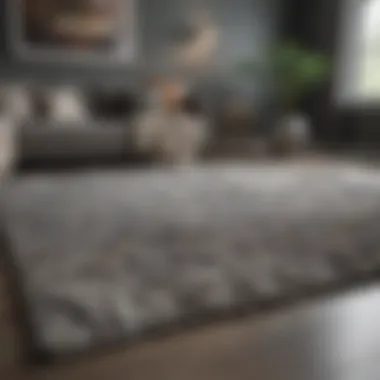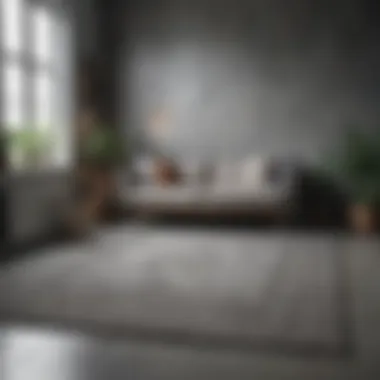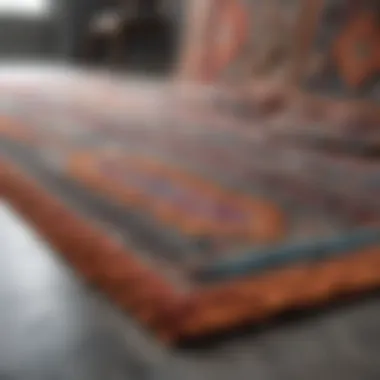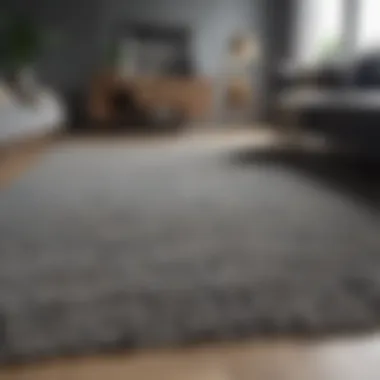Enhancing Gray Walls: Choosing the Perfect Rugs


Intro
The fusion of textures and colors in interior design can often dictate the character of a living space. One particularly versatile and popular choice for wall color is gray. Its neutrality allows for diversity in decor, making it a favored backdrop in modern homes. However, the addition of a well-chosen rug can significantly enhance the charm and sophistication of gray walls. This exploration will take a closer look at how to navigate the expansive world of rugs to elevate the aesthetic appeal of gray interiors.
Design Inspiration
Current Trends in Interior Design
In recent years, gray has transitioned from mere basic color to a staple in sleek and contemporary designs. Paired with the right rug, gray walls can transform any space into a haven of elegance. Recent trends highlight the growing popularity of minimalism and functional style, where the size, shape, and texture of a rug plays a pivotal role.
Textured rugs, such as chunky weaves or plush shags, add a layer of warmth and coziness against the starkness of gray walls. Additionally, geometric patterns and bold colors are on the rise. These provide a striking contrast that can invigorate a subdued palette, striking a balance between bold and understated.
Color Schemes and Palette Ideas
Choosing the right rug for gray walls involves more than simply matching colors. Understanding complementary color theory is essential. Here are several suggestions to create harmonious ensembles:
- Warm Neutrals: Cream, beige, or taupe rugs provide a soft contrast to cool gray walls, creating a serene and inviting environment.
- Bold Colors: Rich hues like deep navy, emerald green, or warm mustard can stimulate visual interest and elevate the space.
- Patterns and Textures: Rugs with intricate patterns or a mix of textures can break monotony, making the room feel layered and dynamic.
When selecting a rug, consider how its colors will interact with the overall decor and lighting of the space. The right rug can help tie together furniture and decor, establishing a cohesive atmosphere.
"A thoughtfully chosen rug can breathe life into gray-walled interiors, adding warmth, personality, and style."
The key is to strike a balance between the existing elements and the new additions to achieve a harmonious design that resonates with the homeowner's personal style.
Understanding Gray Walls
Gray walls serve as a unique backdrop in interior design, offering a canvas that brings both elegance and flexibility. The significance of understanding gray walls lies in the way they influence the overall aesthetic of a space. Gray shades can either complement or contrast with various elements, most notably rugs. Recognizing this relationship is crucial for homeowners and interior designers seeking to achieve a cohesive interior.
The Versatility of Gray
One of the standout qualities of gray is its versatility. Unlike bold colors, gray can adapt to various design styles, from minimalist to industrial. It acts as a neutral base, allowing for the easy integration of other colors and textures. This adaptability means that the choice of rugs can range widely, from vibrant and patterned to subtle and understated.
Moreover, gray can shift its appearance based on lighting and surrounding decor. For instance, a light gray wall may create a soft, airy feel, while a dark gray can ground a space and meet modern design sensibilities. This property enables homeowners to experiment with an array of design elements.
Popular Shades of Gray
When discussing popular shades of gray, it’s essential to mention the various undertones that can affect color perception in a room.
- Warm Grays: These can have hints of beige or brown and are often inviting. They work well in spaces meant for relaxation.
- Cool Grays: With blue or green undertones, cool grays convey a more contemporary vibe. These hues defintely harmonize with sleek, modern decor.
- Charcoal Grays: Darker shades add drama and sophistication, especially in larger rooms where they create an intimate atmosphere.
- Light Grays: These shades are perfect for smaller spaces, making them appear larger and more open by reflecting natural light.
Each of these shades can dramatically alter both the mood and style of a room. Hence, understanding the type of gray is essential when selected rugs.
Psychological Impact of Gray
The psychological effects of the color gray can be substantial. Gray is often linked with neutrality and balance, presenting a calm environment. However, it can also evoke feelings of dullness if not paired correctly with other colors.
- Calming Effect: Many find gray to foster tranquility, making it suitable for bedrooms and relaxation areas.
- Encouraging Reflection: As a subdued color, gray promotes introspection and a sense of focus. It can be especially useful in home offices or study spaces.
- Risk of Emptiness: Too much gray without contrasting colors may create a sense of emptiness or sterility.
Choosing the right accent pieces, such as rugs, can mitigate the potential drawbacks of gray walls, ensuring a harmonious balance throughout your interiors.
In summary, understanding gray walls is not merely about color but about creating an engaging and thoughtful ambience. This knowledge leads to the careful selection of rugs and other decor elements that enhance the aesthetic beauty of gray walls.


The Role of Rugs in Interior Design
Rugs play a significant role in interior design, particularly when the experience of a space is under scrutiny. Their influence goes beyond mere decoration. A well-selected rug can transform a room’s atmosphere, strengthen its theme and functionality while serving as a critical element for comfort. In the context of gray walls, rugs offer a unique opportunity. They can introduce warmth and vitality, making the cold neutrality of gray feel more inviting.
Moreover, rugs can delineate spaces within an open floor plan. They encourage flow and continuity, guiding the eye from one area to another. As living spaces evolve into multifunctional hubs, rugs become essential in creating separate yet cohesive areas for dining, lounging, or working. The texture and color of rugs allow for nuanced statements about personal style without overwhelming the existing palette.
Functionality Beyond Aesthetics
Rugs serve practical purposes that often go unnoticed. They can reduce noise and provide insulation, making them especially useful in homes or offices with hard surface floors. In addition, rugs also protect floor surfaces from scratches and stains, prolonging their lifespan. This functional aspect is particularly relevant for those with children or pets. The right rug can facilitate a space that is both stylish and resilient, offering a great balance of beauty and utility.
Rug Types and Their Characteristics
When it comes to selecting rugs, understanding the types available is crucial. Here are some notable categories:
- Wool Rugs: Renowned for durability and softness, they offer natural stain resistance. Ideal for high-traffic areas.
- Cotton Rugs: Lightweight and easy to clean, they are suitable for casual spaces. However, they may not last as long under heavy use.
- Synthetic Rugs: Often less expensive, they mimic natural fibers but can be less breathable. Great for outdoor settings.
- Silk Rugs: Luxurious, with a sheen, they work well in low-traffic areas due to their delicate nature.
Each type brings its own set of characteristics that enhance the living experience while influencing the overall design aesthetic. It’s essential to consider where the rug will be placed to select the appropriate material.
Layering Rugs for Visual Interest
Layering rugs can elevate the visual complexity of a space. This method allows different textures, colors, or patterns to coexist harmoniously. For instance, a large neutral base rug can provide a grounded effect, while a smaller patterned rug can introduce an element of surprise.
Some tips for effective layering include:
- Contrast Textures: Pair a plush shag rug with a flatweave for depth.
- Mix Patterns Wisely: Ensure they share a common color palette to maintain coherence.
- Consider Placement: Rugs should overlap but not overcrowd; focus on balance.
Color Theory in Rug Selection
The connection between color and design is both profound and intricate. For spaces with gray walls, understanding color theory in rug selection can significantly influence the overall ambiance. This section offers insight into the elements, benefits, and considerations of color theory as it applies to choosing rugs that enhance gray interiors.
Complementary Colors
Complementary colors are hues that sit opposite each other on the color wheel. When applied in interior design, they can create striking visual contrasts. For example, orange is a complementary color to gray. Introducing a rug with shades of orange or warm terra cotta can create a sense of warmth and vibrancy against the coolness of gray walls. Choose rugs featuring these tones patterned with neutral accents to establish a balance that feels both inviting and dynamic. It’s crucial to consider how these complementary combinations affect the emotional experience of the space.
Contrast and Harmony
Finding the right balance between contrast and harmony is key to any successful design. Gray walls can act as a canvas upon which hues can play against one another. A rug with dark navy or deep purple can create a stark contrast that adds depth to your interior, while a light beige or creamy rug may foster a more soothing atmosphere. When selecting a rug, aim for an interplay of tones that feels coordinated yet not monotonous.
"The attributes of gray allow it to embrace contrasting colors while maintaining a sense of tranquility."
Accent Colors to Consider
Accent colors serve as focal points within a space, drawing the eye and adding interest. When dealing with gray walls, consider hues like teal, mustard yellow, or even blush pink. These colors can be introduced through rugs that contain vibrant patterns or simple designs, enhancing the gray without overwhelming it. Use these accent colors in moderation to punctuate the setting, creating areas of intrigue without losing cohesion. Remember that accent colors should resonate with the overall theme of the room, forging a cohesive atmosphere that invites warmth and complexity.
Ultimately, integrating color theory into rug selection for gray walls allows homeowners and designers to create spaces that are not only aesthetically pleasing but also emotionally resonant. By understanding how colors interact, one can craft interiors that tell a story through their color palettes.
Selecting Rugs for Gray Walls
Choosing the right rug for gray walls is a crucial aspect of interior design that can significantly influence the overall ambiance of a space. The interaction of color, texture, and design plays an important role in how the rug harmonizes with the gray backdrop. Gray, being a neutral color, offers flexibility but also requires careful selection to maintain a balanced aesthetic.
When selecting rugs, consider how each element aligns with your personal style and the function of the room. The right rug can not only enhance the visual appeal but also provide warmth and comfort, making it an essential component in design.


Analyzing Space Dimensions
Understanding the dimensions of the space is vital for selecting the appropriate rug. Measure the area where the rug will be placed accurately. Consider both the floor plan and the layout of the furniture, as these factors will dictate the size and shape of the rug to avoid a cramped or overwhelming feel. A rug that is too small may look lost, while one that is too large can dominate the space.
It's also essential to consider the ceiling height and the flow of the room. A low ceiling could be complemented by lighter, smaller rugs to promote an airy feel, while a spacious room might benefit from larger, bolder patterns.
Determining the Right Size
Once you have assessed the dimensions of the room, think about the proper size for your rug. Typically, it’s useful to follow the general guideline that the front legs of your furniture should rest on the rug, creating a cohesive grounding effect. For dining areas, select a rug that is large enough to accommodate chairs being pulled out without slipping off the edge.
Consider the following size options:
- Area rugs that fit under furniture, creating distinct zones.
- Runner rugs in hallways to add flow and continuity.
- Small accent rugs to highlight specific areas.
Getting the size right can impact the room’s functionality and style. A well-chosen rug can delineate spaces, especially in open-plan living areas.
Texture Considerations
Texture plays a critical role in enhancing a rug's impact against gray walls. Incorporating different textures can create visual interest and add depth to the design. Consider the feel of the rug material in relation to other elements within the room. For instance, a plush shag rug can provide a cozy contrast to smooth walls, while a flat-woven rug can offer a refined touch.
Also, think about the function of the space. High-traffic areas require durable materials, such as polypropylene or wool blends. Conversely, softer materials, like silk, may suit low-traffic zones.
In short, balancing size, texture, and dimensions when selecting rugs for gray walls results in a refined space that is both functional and visually appealing.
Styles and Patterns in Rugs
The selection of rugs can significantly influence a room’s overall appearance, especially when paired with gray walls. Understanding the various styles and patterns available can aid homeowners and designers in making informed decisions that enhance the visual appeal of a space. Each design element can serve a distinct purpose, from adding warmth to injecting personality.
Traditional vs. Modern Designs
Traditional rug designs often feature intricate patterns and rich color palettes that draw on historical aesthetics. These rugs can introduce a sense of elegance and sophistication to gray walls while providing a striking contrast. Common motifs may include floral and paisley designs, which add softness and warmth to a room.
In contrast, modern designs lean towards minimalism, emphasizing simplicity and geometric shapes. Such rugs tend to incorporate bold colors and lines, creating a sleek and contemporary look. Choosing between traditional and modern styles depends on the desired atmosphere of the room. A traditional rug can soften the starkness of gray, while a modern one can complement a more industrial or minimalist theme.
To effectively integrate these styles, consider the existing decor. Traditional designs often work well in formal settings, while modern options are suitable for casual or eclectic spaces.
Geometric Patterns and Their Impact
Geometric patterns in rugs possess a unique ability to draw the eye and create focal points within a room. When placed against gray walls, these patterns can enhance the feeling of depth and movement. The angles and shapes can play a crucial role in defining the aesthetic of the space.
Incorporating geometric designs can also facilitate contrast with gray tones. A rug with sharp lines and bold patterns may stand in stark relief against a muted background, thus injecting energy into the room. This works particularly well in modern or contemporary interiors.
Moreover, geometric patterns can influence perceptions of a room’s size. Smaller patterns, when used thoughtfully, can make a space feel cozy, while larger, bold designs can create an illusion of openness. It’s essential to consider the scale of the pattern relative to the size of the room.
Floral and Textural Options
Floral rugs bring a touch of nature indoors and can soften the look of gray walls. Whether through soft, muted tones or vibrant hues, floral designs can evoke feelings of tranquility and freshness. Such rugs often incorporate natural colors, which can harmonize beautifully with gray, enhancing the room's overall ambiance.
Textural options also play a vital role in rug selection. A plush, shaggy rug can add warmth and comfort to a space dominated by cool gray tones. Textures can invite touch and create layers in the interior design, offering an inviting atmosphere. It is worth exploring various materials, like wool or cotton, to determine which textures best suit your personal taste and the specific needs of your room.
Consider the impact of your rug’s texture and pattern. A well-chosen rug not only amplifies style but also contributes to the overall comfort of a space.


In summary, the interplay of styles and patterns in rugs is crucial in achieving a cohesive interior design. Traditional and modern designs offer diverse aesthetics, while geometric patterns provide dynamic interest. Floral rugs and various textures can contribute warmth and personality. When selecting a rug for gray walls, consider the emotional and visual effects that different styles and patterns can offer.
Maintenance and Care for Rugs
Maintaining and caring for rugs is vital for their longevity and appearance, particularly when paired with gray walls. Gray hues often highlight the rug's color and texture, making any dust or stains stand out. A well-maintained rug can significantly elevate the aesthetic of a space. Homeowners should be aware of the specific cleaning methods and protections suitable for their rug's material to ensure they remain pristine.
Regular Cleaning Techniques
Regular cleaning of rugs is fundamental to keeping them looking fresh and vibrant. Dust, dirt, and allergens accumulate over time, affecting the air quality in the home. Here are some effective techniques:
- Vacuum Regularly: Aim to vacuum your rug once a week. Use a vacuum cleaner with a beater bar or suction setting appropriate for the rug material. Always vacuum in the direction of the fibers to avoid damage.
- Shake Out Loose Debris: For smaller rugs, take them outside and shake them to remove debris. This can be done monthly to enhance cleanliness.
- Brushing: Use a soft-bristle brush to gently remove dirt and refresh the pile. This can help keep the fibers upright and prevent matting.
Regularly implementing these techniques not only helps maintain the rug’s beauty but also prolongs its life.
Stain Removal Guidelines
Stains can be particularly noticeable on rugs with gray walls as they contrast sharply against the muted background. Addressing stains promptly is crucial to avoid permanent damage. Consider the following approaches:
- Blot, Don’t Rub: For fresh spills, use a clean cloth to blot the liquid rather than rubbing it, which can spread the stain.
- Use Mild Detergents: Create a solution of equal parts white vinegar and water or use a mild detergent diluted in water. Apply it sparingly with a cloth.
- Rinse and Dry: After cleaning, rinse the area with a small amount of cold water and dry it with a towel. Avoid saturating the rug, as excess moisture can lead to mold.
Important: Always test any cleaning solution on a hidden area first to ensure it does not cause discoloration.
Protective Measures Against Wear
Protecting your rug from everyday wear is essential, especially in high-traffic areas. The following measures can help maintain the rug’s appearance and durability:
- Use a Rug Pad: Always place a suitable rug pad underneath. This adds cushioning and prevents slipping, which reduces wear on the rug.
- Rotate Regularly: If possible, rotate the rug every few months. This helps it wear evenly, as some areas may receive more foot traffic.
- Avoid Direct Sunlight: Position the rug away from direct sunlight to prevent fading and discoloration. Consider using window treatments to minimize sun exposure.
By incorporating these maintenance practices, homeowners can ensure that their rugs continue to complement gray walls and maintain their intended aesthetic while standing the test of time.
Final Considerations
In this exploration of rugs for gray walls, several key aspects warrant careful reflection. Final considerations are paramount as they encompass the practical and aesthetic decisions influencing the integration of rugs into living spaces. These decisions not only enhance visual appeal but also contribute to the overall functionality and comfort of a room. Understanding how to effectively blend rugs with gray walls helps create a cohesive ambiance.
Integrating Rugs into Existing Spaces
Integrating rugs into spaces already adorned with gray walls requires a keen eye for balance and proportion. It is essential to analyze the room’s existing elements, such as furniture and decor. The chosen rug should complement these aspects rather than compete with them. One approach involves selecting a rug that introduces a new texture or color while still harmonizing with the gray tones.
- Consider the size: The dimensions of the rug must be proportionate to the furniture layout. For example, a larger rug can unify a sprawling area, while a smaller one can accentuate specific seating arrangements.
- Texture matters: A plush shag rug might add warmth, while a flatwoven rug can offer a more contemporary feel. Each can influence the perception of space.
Evaluating Long-Term Trends
The realm of interior design is dynamic, with trends constantly evolving. However, gray walls have maintained a steady popularity due to their versatility. When selecting rugs, consider not only current styles but also their potential longevity. Investing in a rug that transcends fleeting trends can save time and money in the long run.
"Opt for timeless designs that will not only satisfy current tastes but will also remain relevant through changing aesthetics."
Some enduring styles include:
- Solid colors: These provide adaptability with varied decor.
- Subtle patterns: Offer texture without overwhelming the space.
Focusing on such enduring features ensures that your choices remain attractive and functional over time.
Personalizing Your Space
Personalization conveys individual style and creates a sense of belonging within a space. When decorating with rugs against gray walls, incorporate elements that resonate with personal taste. This could involve mixing patterns, textures, or colors that reflect one’s personality.
- Layering rugs: This technique allows for creativity and can adapt to seasonal changes.
- Artwork and accessories: Choose decorative elements that can enhance the rug’s aesthetic and relate to the overall theme.
Ultimately, personalizing your environment fosters enjoyment and comfort, making it a place of solace and expression. The blend of aesthetic choices alongside functionality elevates the significance of rugs in achieving harmony with gray walls.



